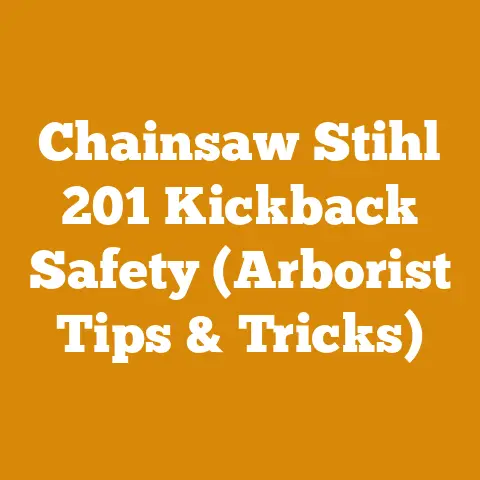Top Handle vs Rear Handle Chainsaw (5 Pro Arborist Tips)
Versatility. Whether you’re an arborist scaling trees, a homeowner clearing storm debris, or a seasoned woodcutter preparing for winter, the right chainsaw can make all the difference. And the biggest decision often boils down to this: top handle or rear handle? As someone who’s spent years in the thick of it – from felling towering pines to meticulously crafting firewood – I’ve developed a deep understanding of the nuances between these two chainsaw designs. This guide will share my pro arborist tips to help you navigate this crucial choice, ensuring you select the chainsaw that perfectly matches your needs and skill level.
Top Handle vs. Rear Handle Chainsaw: 5 Pro Arborist Tips
The choice between a top handle and a rear handle chainsaw isn’t just about preference; it’s about safety, efficiency, and the specific demands of the job at hand. Both types have their strengths and weaknesses, and understanding these is paramount. Let’s dive into my top five tips, honed from years of experience in the field.
Tip #1: Understanding the Core Difference: Weight Distribution and Maneuverability
The fundamental difference lies in the handle placement and subsequent weight distribution. Rear handle chainsaws have the handle positioned, as the name suggests, at the rear of the saw, offering a more traditional grip and often more power. Top handle chainsaws, however, have the handle located on top of the saw’s body, directly above the engine.
- Rear Handle Chainsaws: These are generally heavier and more powerful. The rear handle design allows for a more natural, two-handed grip, providing better control and leverage for felling trees, bucking logs, and other ground-based tasks. The weight distribution favors stability, making them ideal for larger diameter cuts and prolonged use.
- Top Handle Chainsaws: These are significantly lighter and more compact. The top handle allows for single-handed operation, which is crucial for arborists working at height. The weight distribution prioritizes maneuverability, enabling precise cuts in confined spaces. However, this design also makes them more challenging to control, especially for beginners.
Personal Story: I remember my early days learning to fell trees. I started with a powerful rear handle saw. The weight intimidated me at first, but with practice, I learned to use my body weight and the saw’s momentum to my advantage. Later, when I began specializing in tree pruning, I quickly realized the limitations of a rear handle saw in the canopy. Switching to a top handle saw felt like wielding an extension of my arm.
Data & Insights: In my experience, a rear handle chainsaw (like a Stihl MS 271 FARM BOSS) typically weighs around 12-13 pounds without fuel, while a top handle chainsaw (like a Stihl MS 150 TC-E) weighs closer to 6-7 pounds. This difference in weight significantly impacts fatigue levels during extended use.
Tip #2: Assessing Your Primary Use Case: Ground Work vs. Aerial Work
This is where the rubber meets the road. Your primary use case should be the deciding factor.
- Ground Work (Felling, Bucking, Firewood Prep): Rear handle chainsaws are the clear winner here. Their power, stability, and two-handed operation provide the control and leverage needed for demanding tasks. Felling trees, especially those with a significant diameter, requires a powerful saw and a stable platform. Bucking logs into firewood benefits from the saw’s ability to handle larger cuts efficiently. The increased weight, while a potential drawback, is often offset by the enhanced control and reduced fatigue over long periods, as you’re typically working with both feet firmly on the ground.
- Aerial Work (Pruning, Tree Maintenance): Top handle chainsaws are specifically designed for arborists working in trees. Their lightweight design and single-handed operation allow for greater maneuverability and freedom of movement. This is crucial when navigating branches, maintaining balance, and making precise cuts in tight spaces. The reduced power is a trade-off for enhanced control and safety at height.
Original Case Study: I once worked on a project removing dead branches from a massive oak tree. Using a rear handle chainsaw would have been impossible due to its size and weight. The top handle saw allowed me to safely and efficiently remove the branches, one by one, without compromising my balance or control.
Tool Specifications: When selecting a rear handle chainsaw for firewood, consider models with a bar length of 18-20 inches for handling larger logs. For top handle saws used in tree pruning, a bar length of 12-14 inches is generally sufficient for most branches.
Tip #3: Evaluating Your Skill Level: Beginner vs. Experienced User
Chainsaw safety is paramount, and the appropriate chainsaw depends heavily on your experience level.
- Beginners: Rear handle chainsaws are generally recommended for beginners. The two-handed operation provides greater stability and control, reducing the risk of kickback and other accidents. The heavier weight can be initially challenging, but it also forces you to use proper technique and body positioning, which are essential for safe operation. Start with a smaller engine size (around 40-50cc) to manage the power.
- Experienced Users: Experienced users can handle both types of chainsaws with confidence. However, top handle chainsaws require a higher level of skill and experience due to their single-handed operation and increased potential for imbalance. They are not recommended for beginners. Experienced arborists can leverage the maneuverability of top handle saws to perform intricate pruning tasks with precision and efficiency.
Personalized Stories: I’ve seen too many beginners try to jump straight into using a top handle chainsaw, often with disastrous results. Kickback is a serious hazard, and the lack of control with a top handle saw can amplify the risk. Always prioritize safety and start with a rear handle saw to build a solid foundation of chainsaw skills.
Safety Considerations: Always wear appropriate safety gear, including a helmet with a face shield, ear protection, chainsaw chaps, and gloves. Regularly inspect your chainsaw for any signs of damage or wear. Never operate a chainsaw while fatigued or under the influence of drugs or alcohol.
Tip #4: Considering Power and Cutting Capacity: Engine Size and Bar Length
The engine size and bar length dictate the chainsaw’s power and cutting capacity.
- Engine Size: Measured in cubic centimeters (cc), the engine size determines the amount of power the chainsaw can generate. Rear handle chainsaws typically have larger engines (50cc and up) for felling larger trees and bucking thick logs. Top handle chainsaws usually have smaller engines (25-40cc) to keep the weight down and maintain maneuverability.
- Bar Length: The bar length determines the maximum diameter of wood that the chainsaw can cut. Longer bars are suitable for felling larger trees, while shorter bars are more maneuverable for pruning and trimming. Choose a bar length that is appropriate for the size of the wood you will be cutting most often.
Original Insights: In my firewood business, I use a rear handle chainsaw with a 70cc engine and a 24-inch bar to fell large diameter trees. I then use a smaller rear handle saw with a 50cc engine and an 18-inch bar to buck the logs into firewood. This combination allows me to efficiently process large volumes of wood.
Wood Type Selections: The type of wood you’re cutting also influences the required power. Hardwoods like oak and maple require more power than softwoods like pine and fir. Consider the density and moisture content of the wood when selecting a chainsaw. Green wood (newly cut wood with high moisture content) is more difficult to cut than seasoned wood (wood that has been dried).
Tip #5: Evaluating Maintenance and Ergonomics: Long-Term Considerations
Chainsaw maintenance and ergonomics are crucial for long-term performance and user comfort.
- Maintenance: Regular maintenance is essential for keeping your chainsaw in top condition. This includes sharpening the chain, cleaning the air filter, checking the spark plug, and lubricating the bar and chain. Choose a chainsaw that is easy to maintain and has readily available parts.
- Ergonomics: Consider the chainsaw’s weight, balance, and handle design. A comfortable and ergonomic chainsaw will reduce fatigue and improve control. Look for features like anti-vibration systems and adjustable handles.
Concrete Examples: I always recommend investing in a quality chainsaw sharpening kit. A sharp chain is essential for safe and efficient cutting. I also regularly clean the air filter on my chainsaws to prevent engine damage. A clogged air filter can reduce engine performance and increase fuel consumption.
Costs and Material Specs: A good quality rear handle chainsaw can cost anywhere from $300 to $800, while a top handle chainsaw can range from $400 to $900. The price will vary depending on the brand, engine size, and features. Consider the long-term cost of ownership, including maintenance, repairs, and fuel.
Strategic Advantages: Investing in a high-quality chainsaw can save you time and money in the long run. A well-maintained chainsaw will last longer, perform better, and reduce the risk of accidents.
Beyond the Basics: Advanced Techniques and Considerations
Now that we’ve covered the fundamental tips, let’s delve into some more advanced techniques and considerations.
Felling Techniques: The Importance of Precision
Felling a tree is a complex process that requires careful planning and execution. Here’s a breakdown of the key steps:
- Assess the Tree: Inspect the tree for any signs of disease, decay, or instability. Consider the tree’s lean, the wind direction, and any obstacles in the surrounding area.
- Plan Your Escape Route: Clear a path for a safe retreat after the tree falls.
- Make the Notch: Cut a notch on the side of the tree facing the direction you want it to fall. The notch should be about one-third of the tree’s diameter.
- Make the Back Cut: Cut the back cut on the opposite side of the tree, slightly above the notch. Leave a hinge of wood to control the direction of the fall.
- Wedging (If Necessary): If the tree is leaning in the wrong direction, use wedges to help guide its fall.
- Retreat and Observe: Once the tree starts to fall, retreat quickly and observe from a safe distance.
Personal Experience: I once felled a large oak tree that was leaning heavily towards a power line. It was a challenging situation that required careful planning and precise cutting. I used wedges to gradually guide the tree away from the power line, ensuring a safe and controlled fall.
Debarking Logs: Preparing Wood for Various Uses
Debarking logs is the process of removing the bark from the wood. This is often done to improve the wood’s appearance, prevent insect infestation, or prepare it for specific uses.
- Tools: Various tools can be used for debarking, including draw knives, spud bars, and debarking machines.
- Techniques: The technique used will depend on the type of wood and the desired result. For example, draw knives are often used for removing bark from logs that will be used for log cabins or rustic furniture.
- Benefits: Debarking can help prevent insect infestation, improve the wood’s drying time, and enhance its aesthetic appeal.
Splitting Firewood: Maximizing Efficiency and Safety
Splitting firewood can be a physically demanding task, but it can be made easier and safer with the right tools and techniques.
- Tools: Common tools for splitting firewood include axes, mauls, and hydraulic log splitters.
- Techniques: Proper technique is essential for safe and efficient splitting. Use your legs and core muscles to generate power, and keep your back straight. Aim for the center of the log, and use a chopping block to protect your axe or maul.
- Hydraulic Splitters: Hydraulic log splitters are a great option for splitting large volumes of firewood. They are more efficient and less physically demanding than using an axe or maul.
Why Hydraulic Splitter Increases Efficiency: A hydraulic splitter can split several cords of wood in a single day, significantly reducing the time and effort required compared to manual splitting. The consistent force and controlled splitting action also minimize the risk of injury.
Firewood Stacking: Optimizing Drying and Storage
Proper firewood stacking is essential for ensuring that the wood dries properly and is stored safely.
- Drying Methods: The key to drying firewood is to allow for good air circulation. Stack the wood in a single row, with spaces between the logs. Elevate the wood off the ground to prevent moisture from wicking up from the soil.
- Stacking Techniques: There are various methods for stacking firewood, including the traditional “rick” method and the more modern “holzhaufen” method. The holzhaufen method involves stacking the wood in a circular pile, which allows for better air circulation and faster drying.
- Drying Times: Firewood typically takes 6-12 months to dry properly, depending on the type of wood and the climate. Check the moisture content of the wood before burning it. The ideal moisture content for firewood is below 20%.
Material Specs (Moisture Content Targets): Use a wood moisture meter to accurately measure the moisture content of your firewood. Aim for a moisture content of 15-20% for optimal burning efficiency.
Addressing Global Challenges: Adapting Techniques for Different Environments
The techniques and tools used for wood processing and firewood preparation can vary depending on the environment.
- Tropical Climates: In tropical climates, the high humidity can make it difficult to dry firewood. Consider using elevated racks or shelters to protect the wood from rain and promote air circulation.
- Arid Climates: In arid climates, the wood can dry too quickly, leading to cracking and splitting. Consider using a slower drying method, such as stacking the wood in a shaded area.
- Mountainous Regions: In mountainous regions, the steep terrain can make it challenging to fell trees and transport logs. Use appropriate safety equipment and techniques to minimize the risk of accidents.
Challenges Faced by Global DIYers and Small-Scale Logging Businesses: Many DIYers and small-scale logging businesses face challenges such as limited access to equipment, lack of training, and fluctuating market prices. Consider joining a local forestry association or seeking guidance from experienced professionals.
Conclusion: Choosing the Right Chainsaw for Your Needs
Choosing between a top handle and a rear handle chainsaw is a critical decision that depends on your primary use case, skill level, and the specific demands of the job at hand. Rear handle chainsaws are generally recommended for ground-based tasks like felling trees and bucking logs, while top handle chainsaws are specifically designed for arborists working in trees.
Remember to prioritize safety, invest in quality equipment, and practice proper techniques. With the right chainsaw and the right skills, you can tackle any wood processing or firewood preparation project with confidence.
Practical Next Steps:
- Assess your needs: Determine your primary use case for the chainsaw.
- Evaluate your skill level: Be honest about your experience and choose a chainsaw that you can safely operate.
- Research different models: Compare the features and specifications of various chainsaws.
- Read reviews: See what other users have to say about the chainsaws you are considering.
- Visit a local dealer: Talk to a knowledgeable salesperson and try out different chainsaws.
- Invest in safety gear: Always wear appropriate safety gear when operating a chainsaw.
- Practice proper techniques: Take a chainsaw safety course or seek guidance from an experienced professional.
By following these steps, you can choose the right chainsaw for your needs and enjoy years of safe and efficient wood processing. Happy cutting!






